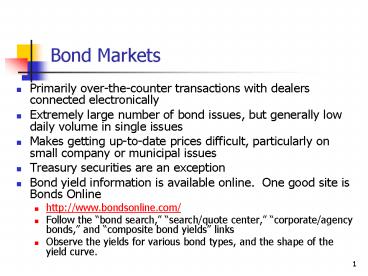Bond Markets - PowerPoint PPT Presentation
Title:
Bond Markets
Description:
Bond Markets Primarily over-the-counter transactions with dealers connected electronically Extremely large number of bond issues, but generally low daily volume in ... – PowerPoint PPT presentation
Number of Views:58
Avg rating:3.0/5.0
Title: Bond Markets
1
Bond Markets
- Primarily over-the-counter transactions with
dealers connected electronically - Extremely large number of bond issues, but
generally low daily volume in single issues - Makes getting up-to-date prices difficult,
particularly on small company or municipal issues - Treasury securities are an exception
- Bond yield information is available online. One
good site is Bonds Online - http//www.bondsonline.com/
- Follow the bond search, search/quote center,
corporate/agency bonds, and composite bond
yields links - Observe the yields for various bond types, and
the shape of the yield curve.
2
Corporate Bond Price Reporting
- Coupon rate 8.375
- Coupon payment per year 83.75 0.08375 X
1,000 - Bond matures on July 15, 2033
- Trading volume 763,528,000 (Face value of
bonds traded) - Quoted price 100.641 of face value, so if face
value is 1,000, the price is 1,006.41. - Bond prices are quoted as a percent of par, just
as the coupon is quoted as a percent of par. - The bonds yield (8.316) is 362 basis points
(3.62) above the comparable maturity Treasury
bond yield (30-year Treasury bond yield). - 100 basis points 1
- Current yield 8.322
- Computed as annual coupon divided by current
price (83.75 / 1,006.41 8.32)
3
Corporate Bond Price Reporting Continued
- How can we determine the yield on GM bond?
- To do that we use another TI BA II PLUS worksheet
BOND - Date entry mm.ddyy
- 2ND BOND
- 2ND CLR WORK
- 01.1305 ENTER (Settlement date.)
- 8.375 ENTER (Annual coupon interest rate in
percent form.) - 07.1533 ENTER (Maturity date.)
- 100 ENTER (Face value entered as 100. If the
bond has a call price it can be set to that.) - ACT (ACT is actual day count. Can be changed
to 360 by using 2ND SET) - 2/Y (Coupon payment per year. Can be changed
to 1/Y by using 2ND SET) - Since we are computing yield (YLD)
- 100.641 ENTER (Non-negative price of the bond as
a of face value.) - CPT (Go back to YLD to compute.)
- AI (AI is Accrued Interest as dollar amount
per face value amount.) - DUR (DUR is Duration of the bond average
time it takes to recover the market price.)
4
Clean and Dirty Price of a Bond
- How much do you think you will pay for the
previous bond per 100 par value? - Price a buyer would pay will include Accrued
Interest (AI) if a bond is purchased after the
last coupon but before the next coupon payment - This is because a seller is entitled to receive
some of the next coupon payment based on the
fraction of six month period she owned it. - A quotation excluding AI is called Clean Price
- What you pay for the bond is called Dirty Price
- Dirty Price Clean Price Accrued Interest
- Dirty Price 100.641 4.142 104.783
- AI is quite close to 8.375 / 2 4.1875 since we
are short by two days to make it a full six month
period (1/13/05 vs. 1/15/05) - 4.1875 178/180 4.141
- You pay Dirty Price (Clean Price AI) to the
seller and get the next coupon in two days in full
5
More on Clean and Dirty Price of a Bond
- Why do dealers quote clean price then?
- Clean prices excludes price drops of bonds due to
a coupon payment. - This drop can also be observed for stock when
there is a dividend payment. - Clean prices change not because of a coupon
payment but rather because of a change in general
direction of interest rates or a change in the
credit quality of borrower
6
Treasury Bond Price Reporting
- Coupon rate 9
- Matures in November 2018
- Bid price (Dealers Bid dealer is willing to
pay) is 145 and 25/32 percent of par value. - 14525 (14525/32) of par value 145.78125
of par value - If you want to sell 100,000 par value T-bonds,
the dealer is willing to pay 1.4578125(100,000)
145,781.25 - Ask price (Dealers Ask dealer is willing to
receive) is 145 and 26/32 percent of par value. - 14526 (14526/32) of par value 145.8125 of
par value - If you want to buy 100,000 par value T-bonds,
the dealer is willing to sell them for
1.458125(100,000) 145,812.50 - The difference between the bid and ask prices is
called the bid-ask spread and it is how the
dealer makes money. - Note that Ask Price is higher than Bid Price.
Why is that? - The price changed by 22/32 percent or 687.50 for
a 100,000 worth of T-bonds (22/32) of par. - (22/32) 0.6875 and 0.6875 X 100,000
687.50. - The yield based on the ask price is 4.51
7
Treasury Bond Price Reporting Continued
- If the date of quotation is January 14, 2005 and
exact maturity date is 11/15/2018 what is the
yield based on ask price? - 2ND BOND
- 2ND CLR WORK
- 01.1405 ENTER (Settlement date.)
- 9.000 ENTER (Annual coupon interest rate in
percent form.) - 11.1518 ENTER (Maturity date.)
- 100 ENTER (Face value entered as 100. If the
bond has a call price it can be set to that.) - ACT (ACT is actual day count. Can be changed
to 360 by using 2ND SET) - 2/Y (Coupon payment per year. Can be changed
to 1/Y by using 2ND SET) - Since we are computing yield (YLD)
- 145.8125 ENTER (Non-negative price of the bond as
a of face value.) - CPT (Go back to YLD to compute.































